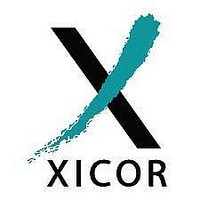X9409 Xicor, X9409 Datasheet - Page 3

X9409
Manufacturer Part Number
X9409
Description
Quad Digitally Controlled Potentiometers
Manufacturer
Xicor
Datasheet
1.X9409.pdf
(21 pages)
Available stocks
Company
Part Number
Manufacturer
Quantity
Price
Company:
Part Number:
X9409WS24I-2.7
Manufacturer:
Intersil
Quantity:
163
Part Number:
X9409WV
Manufacturer:
XICOR
Quantity:
20 000
Part Number:
X9409WV24I-2.7T1
Manufacturer:
XICOR
Quantity:
20 000
Part Number:
X9409WV24I-2.7T2
Manufacturer:
XICOR
Quantity:
20 000
Company:
Part Number:
X9409WV24IZ-2.7
Manufacturer:
STM
Quantity:
99
Part Number:
X9409WV24IZ-2.7T1
Manufacturer:
INTERSIL
Quantity:
20 000
Part Number:
X9409YS24Z
Manufacturer:
INTERSIL
Quantity:
20 000
X9409 – Preliminary Information
PRINCIPLES OF OPERATION
The X9409 is a highly integrated microcircuit
incorporating four resistor arrays and their associated
registers and counters and the serial interface logic
providing direct communication between the host and
the XDCP potentiometers.
Serial Interface
The X9409 supports a bidirectional bus oriented
protocol. The protocol defines any device that sends
data onto the bus as a transmitter and the receiving
device as the receiver. The device controlling the
transfer is a master and the device being controlled is
the slave. The master will always initiate data transfers
and provide the clock for both transmit and receive
operations. Therefore, the X9409 will be considered a
slave device in all applications.
Clock and Data Conventions
Data states on the SDA line can change only during
SCL LOW periods (t
SCL HIGH are reserved for indicating start and stop
conditions.
Start Condition
All commands to the X9409 are preceded by the start
condition, which is a HIGH to LOW transition of SDA
while SCL is HIGH (t
monitors the SDA and SCL lines for the start condition
and will not respond to any command until this
condition is met.
Stop Condition
All communications must be terminated by a stop
condition, which is a LOW to HIGH transition of SDA
while SCL is HIGH.
Acknowledge
Acknowledge is a software convention used to provide
a positive handshake between the master and slave
devices on the bus to indicate the successful receipt of
data. The transmitting device, either the master or the
slave, will release the SDA bus after transmitting eight
bits. The master generates a ninth clock cycle and
during this period the receiver pulls the SDA line LOW
to acknowledge that it successfully received the eight
bits of data.
REV 1.6 1/30/03
LOW
HIGH
). SDA state changes during
). The X9409 continuously
www.xicor.com
The X9409 will respond with an acknowledge after
recognition of a start condition and its slave address
and once again after successful receipt of the
command byte. If the command is followed by a data
byte the X9409 will respond with a final acknowledge.
Array Description
The X9409 is comprised of four resistor arrays. Each
array contains 63 discrete resistive segments that are
connected in series. The physical ends of each array
are equivalent to the fixed terminals of a mechanical
potentiometer (V
At both ends of each array and between each resistor
segment is a CMOS switch connected to the wiper
(V
switch may be turned on at a time. These switches are
controlled by the Wiper Counter Register (WCR). The
six bits of the WCR are decoded to select, and enable,
one of sixty-four switches.
The WCR may be written directly, or it can be changed
by transferring the contents of one of four associated
Data Registers into the WCR. These Data Registers
and the WCR can be read and written by the host
system.
Device Addressing
Following a start condition the master must output the
address of the slave it is accessing. The most
significant four bits of the slave address are the device
type identifier (refer to Figure 1 below). For the X9409
this is fixed as 0101[B].
Figure 1. Slave Address
The next four bits of the slave address are the device
address. The physical device address is defined by the
state of the A0-A3 inputs. The X9409 compares the
serial data stream with the address input state; a
successful compare of all four address bits is required
for the X9409 to respond with an acknowledge. The
A
signals or tied to V
0
W
–A
/R
3
W
inputs can be actively driven by CMOS input
) output. Within each individual array only one
0
Device Type
Identifier
1
H
/R
CC
Characteristics subject to change without notice.
0
H
or V
and V
1
SS
L
.
A3
/R
Device Address
L
inputs).
A2
A1
A0
3 of 21












